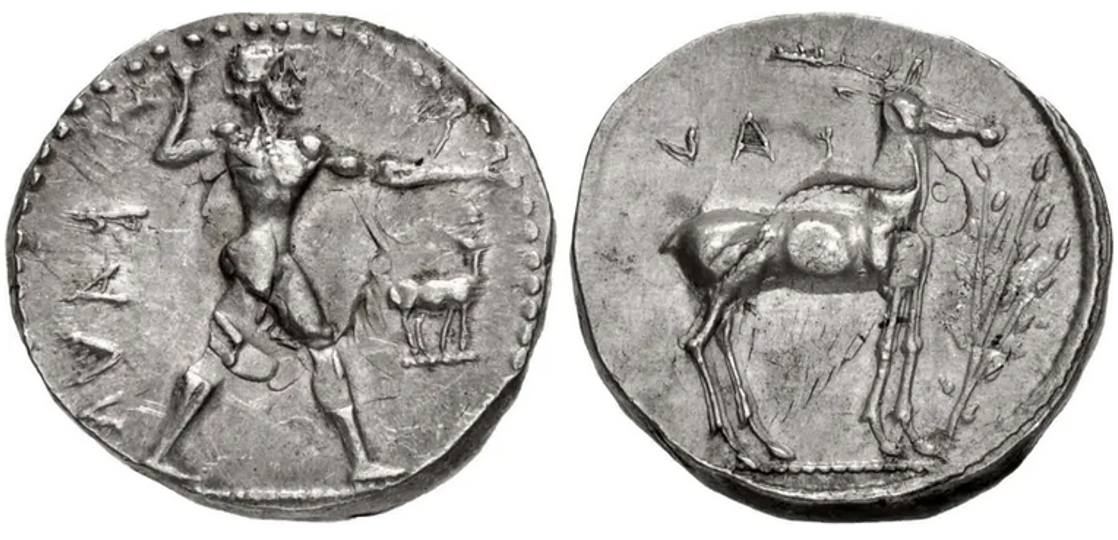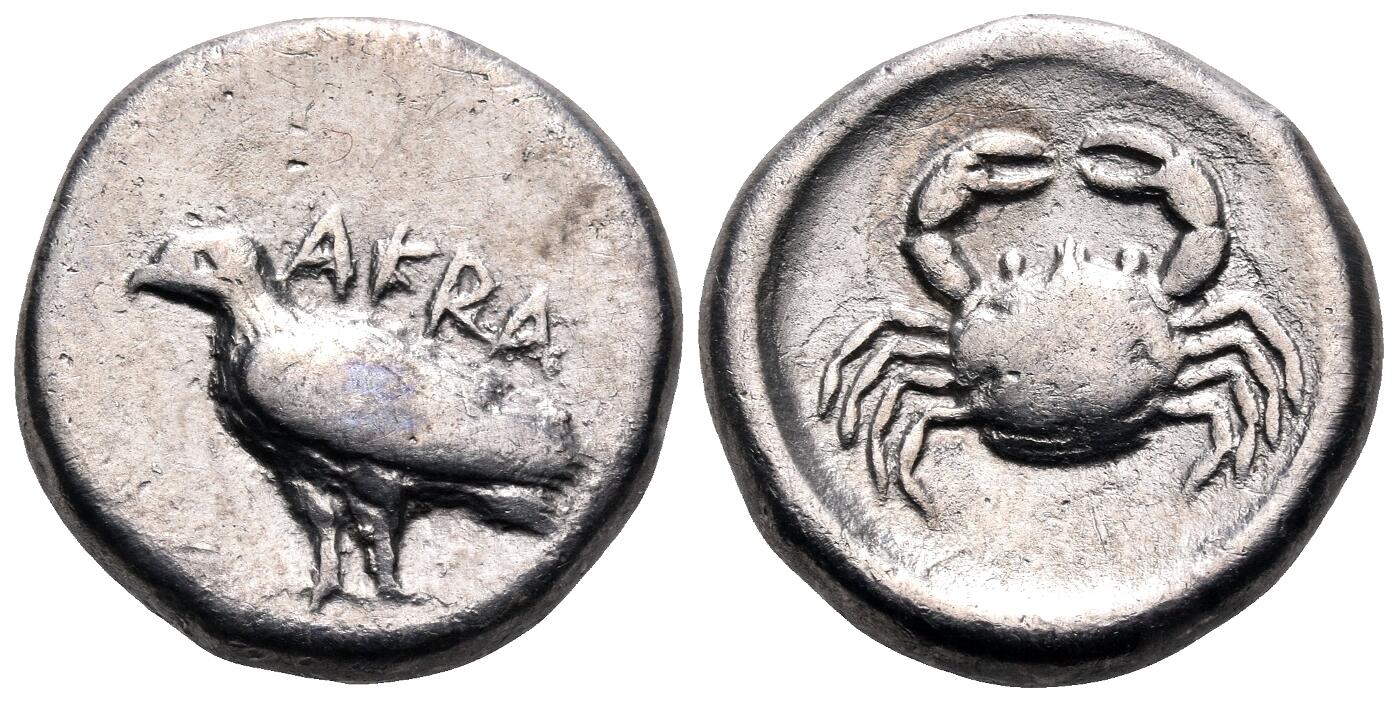475 BCE - 425 BCEKAVΛ (retr.) | KAVΛ (retr.)
Overstriking coin
SO 2166 - Caulonia over Akragas.png
[1]
Overstruck variety
Akragas (SO 2269).jpg
|
|
Sale(s)Sale(s) ᵖ:
|
Classical Numismatic Group, 72, 14 June 2006, 137 = CNG Feature Auction 118, 13 Sept. 2021, 33
|
| Private collection(s)Private collection(s) ᵖ:
|
Mercury Group Collection
|
|
Description
| ObverseInscription or printing placed on the obverse.:
|
KAVΛ (retr.) (Greek) Apollo advancing right, holding branch. Small daimon running right on Apollo's left arm. To right, stag standing right, head reverted.
|
ReverseInscription or printing placed on the reverse.:
|
KAVΛ (retr.) (Greek) Stag right. In the right field, laurel branch.
|
Mint and issuing power
| MintIdentifies the place of manufacture or issue of a numismatic object.:
|
Caulonia
|
Ancient regionAncient region.
|
Bruttium
|
Modern countryModern country: Italy
|
AuthorityIdentifies the issuing power. The authority can be "pretended" when the name or the portrait of X is on the coin but he/she was not the issuing power. It can also be "uncertain" when there is no mention of X on the coin but he/she was the issuing power according to the historical sources:
|
|
Chronology
| FromIdentifies the initial date in a range assigned in a numismatic context. 475 BCE toIdentifies the final date in a range assigned in a numismatic context.. 425 BCE
|
Classical 480-323 BC  periodTime period of the numismatic object. periodTime period of the numismatic object.
|
Physical description
MetalThe physical material (usually metal) from which an object is made.: Silver 
|
WeightWeight of the numismatic object (in grams). in grams: 8.108.1 g <br />8,100 mg <br />
|
DenominationTerm indicating the value of a numismatic object. Examples: tetradrachm, chalkous, denarius.: nomos
|
AxisDescribes the directional relationship between the obverse and reverse of a numismatic object.: 55 mm <br />0.5 cm <br />
|
| DiameterDescribes diameter of an object (in mm).: 2222 mm <br />2.2 cm <br />
|
|
References
Description
| ObverseInscription or printing placed on the obverse.:
|
Eagle (visible on obverse)
|
ReverseInscription or printing placed on the reverse.:
|
Crab (visible on reverse)
|
Mint and issuing power
| MintIdentifies the place of manufacture or issue of a numismatic object. ᵖ:
|
Agrigentum
|
Ancient regionAncient region. ᵖ
|
Sicily
|
Modern countryModern country: Italy
|
AuthorityIdentifies the authority in whose name (explicitly or implicitly) a numismatic object was issued. ᵖ:
|
|
Chronology
| FromIdentifies the initial date in a range assigned in a numismatic context. 500 BCE toIdentifies the final date in a range assigned in a numismatic context.. 430 BCE
|
Classical 480-323 BC  periodTime period of the numismatic object. periodTime period of the numismatic object.
|
Physical description
| DenominationTerm indicating the value of a numismatic object. Examples: tetradrachm, chalkous, denarius. ᵖ:
|
didrachm 
|
|
|
References
References
- ^ Noe, Sydney P. (1958), The coinage of Caulonia, Numismatic Studies 9, New York, 62 p., 20 pl.
- ^ Rutter N. Keith et alii (eds.) (2001), Historia Numorum Italy, London, xvi, 223 p., 43 pl.
- ^ Hoover, Oliver D. (2018), The Handbook of Greek Coinage Series, Volume 1. Handbook of Coins of Italy and Magna Graecia, Sixth to First Centuries BC., Lancaster-London, 2018, lxi, 527 pages, 23 cm
- ^ Westermark, Ulla (2018), The coinage of Akragas c. 510-406 BC, 2 vol., Uppsala.


